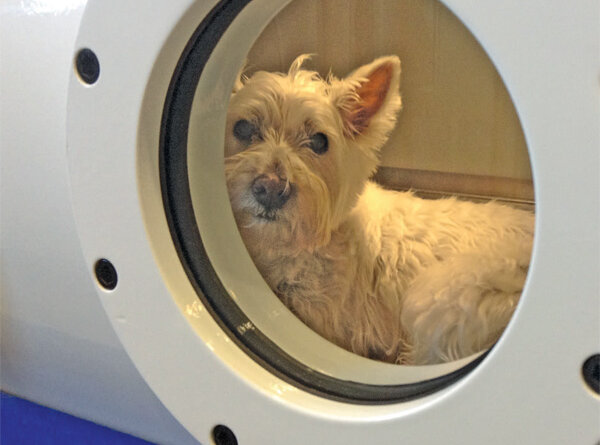Oxygen Therapy for Dogs–Healing with Oxygen
Somewhere in northern California, a tiny dog is still prancing around on four paws thanks to hyperbaric oxygen therapy (HBOT). Unbeknownst to the dog’s owner, a piece of string had become wrapped around his paw, hidden in the dog’s dense fur. As circulation in the paw slowed down, skin and tissue began to slough off. By the time the owner realized what was happening, the paw was in such bad shape that the little dog’s vet, understandably, recommended amputation. The owner, however, wanted to try to save it. After a strict regimen of cleaning and dressing changes failed to promote significant improvement, the dog was referred for HBOT treatment.
Deep-sea and scuba divers have long used HBOT to combat the bends, and in the medical arena, it has been employed for more than 50 years to help people recover from serious infections and hard-to-heal wounds, among other ailments.
Now, this technology is being utilized to help companion animals and horses with conditions as varied as head and spinal-cord trauma, intervertebral disc disease, wounds and burns, infections, and inflammatory conditions.
The general theory behind HBOT is that it promotes healing by raising oxygen levels in the blood, allowing oxygen to diffuse into tissues at distances three to four times further than usual. Gary Richter, MS, DVM, medical director of Holistic Veterinary Care and Rehabilitation Center, Oakland, Calif., is among those who use HBOT in their practices. According to Dr. Richter, “When there’s inflammation, damaged tissues or injury, lack of oxygen is very commonly the limiting factor. By increasing the amount of oxygen delivered to tissues, we are stimulating these patients’ own healing abilities—immune systems, stem cells—to begin the healing process where other types of conventional medicine might not be able to achieve that goal.” (The dog with the damaged paw was treated at Dr. Richter’s clinic.)
GET THE BARK NEWSLETTER IN YOUR INBOX!
Sign up and get the answers to your questions.
Typically, HBOT treatments last about an hour and are given one to two times daily. A patient is placed in a hyperbaric chamber and breathes 100 percent oxygen at 1.5 to 3 times normal atmospheric pressure. The total number of treatments required depends upon the condition and how the patient responds. Being enclosed in the chamber doesn’t seem to distress the dogs or cats who use it; many reportedly go to sleep during treatment. Dr. Richter thinks that for the patient, it’s mainly boring; “as far as the animal’s concerned, nothing’s happening.” The cost and protocol are the same no matter how large or small the patient.
The therapy has essentially no side effects, although Dr. Richter says that it’s also important to select HBOT candidates appropriately. Dogs or cats with some types of respiratory problems or who are predisposed to specific types of seizures need to be evaluated before undergoing the therapy.
And sometimes, says Dr. Richter, the therapy may have positive side effects. Take, for example, the case of a cat with inflammatory bowel disease (IBD) so severe that she required a surgically implanted feeding tube. The surgical site became infected with Methicillin-resistant Staphylococcus aureus (MRSA), a bacterium responsible for several difficult-to-treat infections. HBOT was used to help the site heal and resolve the MRSA, but as a side effect, her IBD improved to the point that she no longer required intensive medical monitoring.
Despite being approved for use in humans for an array of medical conditions, HBOT is not without its skeptics, who say that the lack of clinical trial data supporting its claims puts it into the realm of experimental. However, based on the human experience, it would seem that HBOT has the potential to become another valuable tool in the veterinary health-care toolbox.




